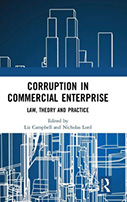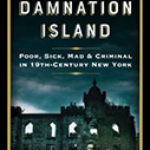Corruption In Commercial Enterprise: Law, Theory And Practice

Editors: Liz Campbell and Nicholas Lord
Publisher: Abingdon, Oxon, UK; New York: Routledge, 2018. 306p.
Reviewer: Colleen P. Eren | January 2019
Although the United States has (according to the Corruption Perception Index of Transparency International) generally avoided the perception of being very corrupt, ranking 16th out of 180 countries, the current investigation by Robert Mueller into Russian interference in the 2016 election and the Trump campaign’s possible complicity has brought the issue of corruption to the forefront of media and societal attention in the US. Indeed, one of the first bills to be introduced by house Democrats in 2019 is a sweeping anti-corruption bill. This renewed salience of corruption in mainstream discourse in the US (although not confined to commercial corruption per se) should make this new book of great interest, utility, and relevance. The editors are well-qualified, prolific scholars in the field: Liz Campbell is Chair of Criminal Jurisprudence at Monash Law School, Australia, author of Organised Crime and the Law: A Comparative Analysis (Hart Publishing, 2013) and Nicholas Lord is Reader in Criminology at the University of Manchester, author of Regulating Corporate Bribery in International Business: Anti-Corruption in the UK and Germany (Routledge, 2016).
Corruption in Commercial Enterprise: Law, Theory and Practice is an interdisciplinary compilation, with contributions from criminologists, law professors, psychologists, and business specialists as well as from former law enforcement and forensic accounting professionals. It focuses primarily on the United Kingdom, but also is comparative — dedicating attention to the United States, Italy, and Ukraine. This is a welcome change from a trove of scholarly work that has treated corruption as somehow endemic to ‘developing’ countries only. Indeed, several chapters will justify this focus by pointing out the ways in which ‘developed’ countries can exacerbate levels of corruption by the creation of large power disparities and the devising of opaque legal structures.
Campbell and Lord’s introductory chapter provides some necessary definitional and theoretical orientation, as they observe: “[Corruption] is used to denote a diverse array of behaviors, human characteristics, states of being and conditions, across varied social contexts, and sometimes is employed without sufficient care or reflection.” Because the word “corruption” is imprecise and dependent, they note, on “one’s theoretical leanings” they limit the scope of the book to the investigation of those illegal financial transactions (especially bribery) where influence or advantage is sought, rather than take an expansive view of other types of behavior often thrown under the “corruption” umbrella. These delimitations allow the book to carve a significant niche for itself among others that purport to study corruption. Importantly, Campbell and Lord also point out the book’s intent to explore the intersections between legitimate commercial enterprise and organized crime, thus exploding the artificially imposed boundaries between the two in politics and often in academic settings/literature.
The book is presented in three thematic sections: organization of corruption in commercial enterprise (five chapters), vulnerabilities to corruption (three chapters) and responses to corruption (six chapters). Internal citations found within the chapters indicated that not only the editors, but also the authors were interested in maintaining the integrity and cohesiveness of the project.
Among the key contributions of the first section are the arguments made by Mark Findlay (Chapter 1, “Corruption as business across market contexts”), who proposes that corruption be seen as a “market choice,” “business practice,” “market force.” or “market arrangement” that arises as the result of power imbalances, rather than interpreted solely through a moral or criminological framework, which brand corruption as somehow separate and distinct from economic relationships and contexts. Rather than seeing developing countries as vulnerable to corruption as a result of a deterministic view of culture, he notes “post-colonial globalizing neoliberalism is creating renewed opportunities for corruption…Free trade and neo-liberal economic imperialism have manipulated indigenous frames of obligation and dependence….it is important to understand corruption as another feature of absentee commercial facilitation rather than some evidence of domestic political and cultural contingency.”
Jay Albanese’s (Chapter 2, “When corruption and organised crime overlap”) through an investigation of US corruption cases, presents a lucid description of the spectrum of corrupt behavior among business entities. On one end of the spectrum are some smaller indices of corrupt behavior in a business (for example, bribes) but the business is chiefly in operation for a legitimate objective. On the other end, there is the presence of serious corruption (e.g. extortion) where the agency acts as (essentially) a criminal enterprise. Useful typologies are provided, including a hierarchy of corruption with descriptions of the offenses, which should be of use to students of white-collar crime.
The remaining chapters–Kenneth Murray’s “Unfair Advantage,” Rose Broad and Nicholas Lord’s “Corruption as a facilitator of human trafficking,” and Liz Campbell’s “The organization of corruption in commercial enterprise” provide excellent overviews of (respectively) the intricate mechanics of laundering the proceeds of drug-trafficking, of the distinct processes (recruitment, transportation and exploitation) in human trafficking which present variable opportunities for corruption that can enable such trafficking, and of how corporate vehicles (companies, trusts and partnerships), by concealing beneficial ownership, can serve as incubators for corruption.
The second, slimmest section of the book “Vulnerabilities to corruption in commercial enterprise,” features the excellent “Mickey-Mouse-money and gingerbread cookies” by Adrian Denkers (Chapter 7), an empirical investigation using a new research method (e.g. cross-lagged correlation, or “Granger causality”) into the impact of bonus culture and organizational measures such as prevention and detection measures and employee training on corruption. Relying on samples of 875 experts in economic crime in the Netherlands, drawn in 2014 and 2016, he found that bonus culture was a strong predictor of corruption, while organizational measures’ impact was insignificant. This chapter is important as it not only supports a growing literature on the pernicious influence of bonus structures, but also overcomes a methodological hurdle often encountered by white-collar crime scholars: the difficulty of conducting experiments that may demonstrate causality.
The final section, “Responding to corruption in commercial enterprise,” may be of greatest interest to compliance professionals, law students, and policymakers, as the various authors describe regulatory bodies and their remit, but also provide a superb discussion of the steady creep away from both active policing of finance by regulators themselves (in favor of self-policing), and away from prosecution in favor of Deferred Prosecution Agreements and the potential ethical and practical problems involved in these broad shifts. Aleksandra Jordanoska, in Chapter 9, “The dark side of finance,” and Liliya Gelemerova, Jackie Harvey and Petrus C. van Duyne in Chapter 10, “Banks assessing corruption risk,” analyze recent trends towards the imposed self-regulation of financial institutions and businesses. Jordanoska’s lucid chapter focuses on UK’s business financial regulator (the Financial Conduct Authority) and its approach to policing corruption by financial institutions. She describes ‘meta-regulatory’ frameworks that guide the FCA’s approach to preventing corruption, wherein large amounts of discretion are granted to financial institutions to design, implement, and assess internal programs. She highlights the meager enforcement docket of the FCA, noting the “compliance-oriented model …in which the regulator prefers to rely on negotiation, advice and persuasion [rather] than through mobilizing formal legal processes.” Of course, as she goes on to argue, this presents notable problems such as cosmetic or creative compliance and over-reliance on the commitment by businesses to comply.
Jordanoka’s chapter connects well with Calum Darling’s chapter 11, “The duty to disclose: implications for corruption in commercial enterprise,” which presents an interesting historical analysis of how the 18th century Scot’s law of a duty to report treason has been vastly extended in the current moment in the context of laws relating to reporting financial crime and corruption that one may come across in one’s business—in other words, the expectation that businesses are to act as their own policemen, with the possibility of criminal charges if they do not. The final two chapters “Negotiating non-contention” by Nicholas Lord and Colin King, and Alan Doig’s “Non-conviction financial sanctions, corporate anti-reparation and their potential role in delivering anti-corruption pay-back,” provide excellent analyses of the increased usage in the UK (as in the US) of non-prosecution outcomes (civil recovery orders and deferred prosecution agreements), and subsequent fines levied against financial institutions. Lord and King provide useful tables detailing civil order recoveries obtained by the Serious Fraud Office, the nature of the case, whether it was self-reported, the unlawful conduct, and the fine imposed, as well as a table giving the pros and cons of such action vis-a-vis prosecution. Doig’s chapter dovetails nicely here, raising questions that are less frequently broached in conversations about fines imposed through Deferred Prosecution Agreements: who has been harmed by the unethical/criminal behavior of the business, how can this be repaid, to whom, through what vehicle, and how do we know that it is effective?
My critiques of the book are minor. Although it provides both a comparative and multidisciplinary approach to corruption, its theoretical/analytical diversity was less pronounced. The authors primarily rely on Cohen and Felson’s Routine Activity Theory and its derivatives in their approaches to analyzing why and how corruption occurs. While certainly rational choice theories are helpful, other criminological approaches could also be integrated to provide a more balanced and rich analysis. The book could have been made more accessible through the use of appendices for students, non-experts and non-EU readers. For example, an appendix with all of the acronyms, some of which were not defined within the chapter nor listed in the index would have improved readability. Another helpful feature would have been an appendix which listed, provide an overview of, and perhaps gave a timeline for, the relevant legislation or resolutions mentioned in the book.
Overall, Corruption in Commercial Enterprise: Law, Theory and Practice is an authoritative, insightful, objective, and well-edited book that should be of benefit to a wide range of scholars, students, and practitioners in the US and UK. It serves as an invaluable reference and provides motivation for even more research in this important subfield.
Colleen P. Eren, Associate Professor of Sociology, William Paterson University


